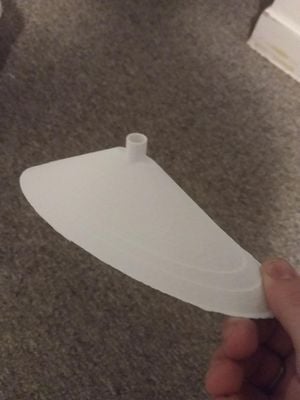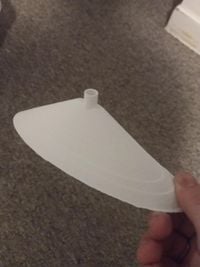Will Omberg (talk | contribs) |
Sophivorus (talk | contribs) m (Text replacement - "| affiliations = " to "| organizations = ") |
||
| (49 intermediate revisions by 9 users not shown) | |||
| Line 1: | Line 1: | ||
[[File:PrintedDiverter.jpg|thumb]] | |||
{{Device data | |||
| manufacturing-files = https://www.thingiverse.com/thing:4022333, https://www.myminifactory.com/object/3d-print-urine-diverter-for-composting-toilet-106620 | |||
}} | |||
{{Project data | |||
| authors = User:Will Omberg | |||
- | | made = Yes | ||
| replicated = No | |||
| cost = USD 1 | |||
| instance-of = Composting toilet | |||
}} | |||
{{777 | {{777 notice}} | ||
When using a [https://en.wikipedia.org/wiki/Composting_toilet composting toilet], it is common practice to separate urine from feces. This reduces the smell and pathogens that are present in the toilet. Excess moisture in the toilet creates an anaerobic environment which promotes the growth of smelly bacteria. The goal of this project is to produce a diverter that can be used on a 5 gallon bucket style toilet. Current models range in price from around $10-40 which is very expensive for a developing community. | |||
When using a [https://en.wikipedia.org/wiki/Composting_toilet composting toilet], it is common practice to separate urine from feces. | |||
[[File:PrintedDiverter.jpg|200px]] | |||
[[File:Diverter.png|200px|right]] | |||
== | == Bill of Materials == | ||
The CAD model and STL can be found at [https://www.myminifactory.com/object/3d-print-urine-diverter-for-composting-toilet-106620 MyMiniFactory] or [https://www.thingiverse.com/thing:4022333 Thingiverse] | |||
1X 5mm flexible plastic tubing or equivalent | |||
1X hose clamp or zip tie | |||
== | == Tools needed == | ||
# [[AthenaII|MOST Delta RepRap]] or similar RepRap 3-D printer | |||
== Skills and knowledge needed == | |||
This print is very basic and requires no supports. It may require a brim to reduce warping. | |||
== Technical Specifications and Assembly Instructions == | |||
To assemble, simply press the tube onto the barb and use a hose clamp or zip tie to secure it in place. | |||
[[ | === Common Problems and Solutions === | ||
The most common problems with this design would be issues with print adhesion and other common printing problems. | |||
== Cost savings == | |||
This device is designed to replace much more expensive diverters that are commercially available. | |||
[https://www.ebay.com/i/323257340165?chn=ps&var=512325424212&norover=1&mkevt=1&mkrid=711-117182-37290-0&mkcid=2&itemid=512325424212_323257340165&targetid=541453987172&device=c&mktype=pla&googleloc=9017742&campaignid=6470549460&mkgroupid=81274343007&rlsatarget=pla-541453987172&abcId=1139336&merchantid=6296724&gclid=Cj0KCQiAz53vBRCpARIsAPPsz8UD1DRLNROZptjXByuHuiS6gkY6WYDd4b0dPIZslKxO3k7hx32U92YaAiJCEALw_wcB This] diverter is one that is commercially available. It is $50.77. | |||
This design can be printed for under $1 | |||
14 ft of tubing can be had for [https://www.amazon.com/Silicone-Flexible-Rubber-Transfer-Homebrew/dp/B07V3N7K85/ref=sr_1_1?qid=1575500694&refinements=p_n_feature_eleven_browse-bin%3A3622111011&s=industrial&sr=1-1 $13] | |||
200 zip ties are about [https://www.amazon.com/Cable-Nylon-Locking-Pieces-Black/dp/B07VRSQ6YL/ref=sr_1_3?keywords=zip+tie&qid=1575500959&s=industrial&sr=1-3-catcorr $4] | |||
This means that this design is 65% cheaper than the alternative. The spare parts are also very useful and can be used for many different things besides this tool. | |||
{{Page data | |||
| keywords = 3D printing, urine diverter funnel, composting toilet, human waste diversion, Plastic, OSAT 3D-Printable Designs | |||
| sdg = SDG11 Sustainable cities and communities, SDG13 Climate action | |||
| organizations = MTU, Michigan_Tech's_Open_Sustainability_Technology_Lab | |||
| license = CC-BY-SA-3.0 | |||
| language = en | |||
}} | |||
[[Category:3D printing]] | |||
[[Category:Plastic]] | |||
[[Category:OSAT 3D-Printable Designs]] | |||
Latest revision as of 16:57, 28 February 2024

When using a composting toilet, it is common practice to separate urine from feces. This reduces the smell and pathogens that are present in the toilet. Excess moisture in the toilet creates an anaerobic environment which promotes the growth of smelly bacteria. The goal of this project is to produce a diverter that can be used on a 5 gallon bucket style toilet. Current models range in price from around $10-40 which is very expensive for a developing community.

Bill of Materials[edit | edit source]
The CAD model and STL can be found at MyMiniFactory or Thingiverse
1X 5mm flexible plastic tubing or equivalent
1X hose clamp or zip tie
Tools needed[edit | edit source]
- MOST Delta RepRap or similar RepRap 3-D printer
Skills and knowledge needed[edit | edit source]
This print is very basic and requires no supports. It may require a brim to reduce warping.
Technical Specifications and Assembly Instructions[edit | edit source]
To assemble, simply press the tube onto the barb and use a hose clamp or zip tie to secure it in place.
Common Problems and Solutions[edit | edit source]
The most common problems with this design would be issues with print adhesion and other common printing problems.
Cost savings[edit | edit source]
This device is designed to replace much more expensive diverters that are commercially available. This diverter is one that is commercially available. It is $50.77.
This design can be printed for under $1
14 ft of tubing can be had for $13
200 zip ties are about $4
This means that this design is 65% cheaper than the alternative. The spare parts are also very useful and can be used for many different things besides this tool.
